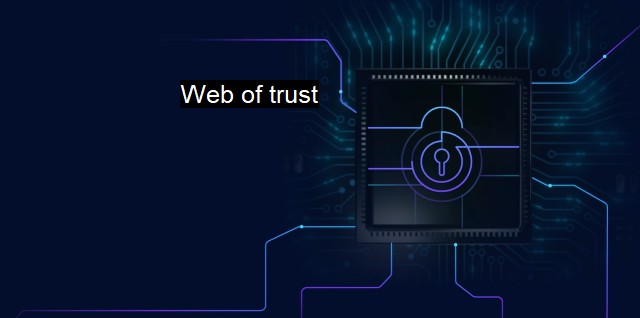What is Web of trust?
Building Trust Online: Understanding the Web of Trust (WoT) Model in Cybersecurity and Antivirus Software
The concept of the "Web of Trust" (WoT) falls under the domain of cybersecurity and antivirus mechanisms. It's an approach that relies on a decentralized, user-driven model for online trust. To fully comprehend the notion of the 'Web of Trust', it's crucial to establish a proper understanding of the conventional "Chain of Trust", from which the WoT model emerged as a solution.The classic Chain of Trust is a hierarchical system. In this model, every step of the structure blindly trusts its predecessor up to the Root of Trust. This method is particularly applicable in situations like digital certificates or Certificate Authority (CA) hierarchy. this approach attracts inherent vulnerabilities concerning the implicit reliance on the Root of Trust and centralized authorities.
Enter the Web of Trust. This alternative scheme decentralizes trust and employs a collaborative approach. Designed by Phil Zimmermann, creator of Pretty Good Privacy (PGP), the WoT model grants each user the autonomy to choose whom they trust, forming a tapestry of interconnected trust relationships. Instead of the all-or-nothing trust of the Chain model, individuals establish and authenticate their unique set of trusted keys.
In the Web of Trust system, trust is transferred using digital signatures on digital encryption keys, implying that each user trusts the owner of the signed key to some extent. When users digitally sign each other's keys, they form what is known as the 'Web of Trust'.
As the backdrop, users confer different levels of trust on each digital signature/key pair. Typically, there are three primary levels: Full, Marginal, and None. Full trust implies trusting the individual to properly validate signatures before signing. Marginal trust is delegated when the individual partially meets validation standards, while None translates to zero faith in the validation process.
The WoT creates paths of trust in intricate yet effective ways. When combined with cryptographic technology, the Web of Trust provides a type of virus protection, mitigating exploits, and hazards by validating the identity of potentially harmful entities and giving the user flags on suspicious activity. Effectively, it makes users active participants eliminating the over-reliance on a centralized authority.
The WoT adds transparency to the security landscape. Any individual can see why a particular node in the trust web is reliable or unreliable and adjust their trust in future interactions accordingly. It proves far reaching and resilient since it extends across numerous locations and doesn't depend on solitary decisions.
To sustain a robust WoT, the PGP community established key-exchange parties or key-signing parties. During these meet-ups, a circle of acquaintances manually exchanges and signs cryptographic keys to form multiple direct paths of trust, amplified and backed up by communal validation.
Even a model as advanced as the Web of Trust isn't free from limitations. Misrepresentation, identity fraud, complacency, and cliques fracture this system, mainly due to wrong or lax practices.
Impersonation poses a significant challenge. While cryptographic security promises reliable encryption and signing, identity assurance isn't guaranteed. Users could validate false identities accidentally, thus spreading distrust on the web. Offline validation presents a viable solution against such problems to guarantee safer practices.
The Web of Trust is envisioned as a mesh of inter-user trust, exceeding the boundaries of geographic locations and communities. When blended with secure cryptographic practices and judicious digital signature validation methods, this model evolves into an intricate, individual-focused defensive approach towards cybersecurity. Despite a few challenges, it indubitably registers as an indispensable way of decentralized trust propagation in our ever-expanding internet era.

Web of trust FAQs
What is Web of Trust (WOT)?
Web of Trust (WOT) is a web browser extension that provides protection against malicious websites. It works by utilizing user ratings and reviews to identify unsafe websites and warn users before they visit them.How does Web of Trust (WOT) protect my computer?
Web of Trust (WOT) uses a color-coded rating system to indicate the safety of websites. When a user visits a website, the WOT extension displays a green, yellow, or red symbol to indicate the site’s safety level. Green indicates a safe site, yellow indicates a site that may be risky, and red indicates a site that is dangerous. This way, users can avoid visiting unsafe websites and protect their computers against malware and viruses.Is Web of Trust (WOT) free?
Yes, Web of Trust (WOT) is a free browser extension that can be downloaded for Chrome, Firefox, and other web browsers.Can I trust the ratings and reviews provided by Web of Trust (WOT)?
Web of Trust (WOT) relies on user-generated ratings and reviews, which means that the accuracy of the ratings can vary. However, WOT has implemented measures to prevent fake reviews and ensure that the ratings reflect the website’s safety level. Additionally, users can contribute to the accuracy of the ratings by submitting their own reviews and ratings.| | A | | | B | | | C | | | D | | | E | | | F | | | G | | | H | | | I | | | J | | | K | | | L | | | M | |
| | N | | | O | | | P | | | Q | | | R | | | S | | | T | | | U | | | V | | | W | | | X | | | Y | | | Z | |
| | 1 | | | 2 | | | 3 | | | 4 | | | 7 | | | 8 | | |||||||